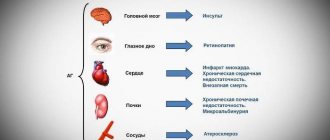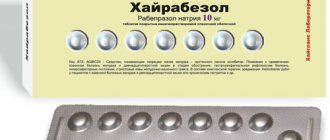Description of the drug EDARBI
When taken orally, Cmax of azilsartan in blood plasma is achieved on average within 1.5-3 hours. The absolute bioavailability of azilsartan medoxomil is approximately 60%. Food intake does not affect the bioavailability of azilsartan.
After single or multiple oral administration in a dose range from 20 mg to 320 mg, the pharmacokinetics of azilsartan medoxomil are dose proportional.
Vd of azilsartan is about 16 l. Plasma protein binding is more than 99%, mainly with albumin. Plasma protein binding remains constant when azilsartan plasma concentrations are significantly higher than the range achieved when taken at recommended doses. Css of azilsartan is achieved within 5 days; its accumulation in the blood plasma does not occur with daily use once a day.
Animal studies with radioactive tracers have shown that the amount of azilsartan that penetrates the BBB is minimal.
After oral administration during absorption from the gastrointestinal tract, azilsartan medoxomil is converted into the pharmacologically active metabolite azilsartan under the action of the enzyme carboxymethylenebutenolidase in the intestines and liver. Azilsartan is metabolized to two primary metabolites primarily in the liver. The main metabolite in blood plasma is formed by O-dealkylation, the minor metabolite by decarboxylation. The AUC values for these metabolites in humans are respectively 50% and less than 1% compared to azilsartan. These metabolites do not affect pharmacological activity. Metabolism of azilsartan occurs mainly with the participation of the CYP2C9 isoenzyme.
Azilsartan and its metabolites are excreted from the body, both through the intestines and the kidneys. Studies have shown that after oral administration of azilsartan medoxomil, about 55% (mainly as a minor metabolite) is found in the feces and about 42% (15% as azilsartan, 19% as the main metabolite) in the urine. T1/2 of azilsartan is about 11 hours, renal clearance is about 2.3 ml/min.
In patients with mild, moderate and severe renal impairment, AUC was increased by 30%, 25% and 95%, respectively. No increase in AUC (5%) was observed in patients with end-stage renal disease on hemodialysis. Clinical data on pharmacokinetics in patients with severe or end-stage renal failure are not available. Azilsartan is not removed from the systemic circulation by hemodialysis.
Use of azilsartan medoxomil for more than 5 days in patients with mild (Child-Pugh class A) or moderate (Child-Pugh class B) hepatic impairment leads to a slight increase in AUC (1.3-1.6 times, respectively). Pharmacokinetics in patients with severe (Child-Pugh class C) hepatic impairment has not been studied.
Edarbi Clo tablets, film-coated 40 mg + 12.5 mg 98 pcs. in Moscow
Combined antihypertensive drug. The composition of the drug Edarbi® Clo includes an angiotensin II receptor antagonist (azilsartan medoxomil) and a thiazide-like diuretic (chlorthalidone). The simultaneous use of two active substances leads to a more pronounced decrease in blood pressure compared to taking each of them in monotherapy. When taking the drug once a day, an effective reduction in blood pressure is achieved within 24 hours.
Azilsartan medoxomil:
- Specific antagonist of angiotensin II type 1 receptors (AT1). Angiotensin II is formed from angiotensin I in a reaction catalyzed by angiotensin-converting enzyme (ACE, kininase II). Angiotensin II is the main vasoconstrictor factor of the RAAS, its actions include vasoconstriction, stimulation of aldosterone synthesis and secretion, increase in heart rate and sodium reabsorption by the kidneys.
- Azilsartan medoxomil is an oral prodrug. It is quickly converted into the active azilsartan molecule, which selectively prevents the development of the effects of angiotensin II by blocking its binding to the AT1 receptor in various tissues, for example, vascular smooth muscle and the adrenal glands. Therefore, its action is not related to the angiotensin II biosynthetic pathway. The AT2 receptor is also found in many tissues, but it is not involved in the regulation of the cardiovascular system. The affinity of azilsartan for the AT1 receptor is 10,000 times higher than for the AT2 receptor.
- Inhibition of RAAS activity through ACE inhibitors, which suppress the formation of angiotensin II from angiotensin I, is widely used in the treatment of arterial hypertension. ACE inhibitors also suppress the breakdown of bradykinin, which is catalyzed by ACE. Since azilsartan does not inhibit ACE (kininase II), it should not affect bradykinin activity. Azilsartan does not bind to or block other receptors or ion channels that play an important role in the regulation of the cardiovascular system.
- Azilsartan dose-dependently suppresses the vasoconstrictor effects of angiotensin II infusion. A single dose of azilsartan at a dose equivalent to 32 mg of azilsartan medoxomil suppressed the maximum vasoconstrictor effect of angiotensin II by approximately 90% at the time of highest concentration, and by approximately 60% 24 hours after administration. In healthy volunteers, plasma concentrations of angiotensin I and angiotensin II and renin activity increased, and aldosterone concentrations decreased after a single oral dose and after repeated doses of azilsartan medoxomil; No clinically significant effect on serum potassium or sodium levels was detected. In general, the pharmacodynamic properties of azilsartan medoxomil are consistent with blocking AT1 receptors.
- The antihypertensive effect of azilsartan medoxomil develops during the first 2 weeks of use with the maximum therapeutic effect achieved after 4 weeks. A reduction in blood pressure after oral administration of a single dose is usually achieved within a few hours and persists for 24 hours.
Chlorthalidone:
- A thiazide-like diuretic, inhibits the active reabsorption of sodium ions in the renal tubules (the initial part of the distal convoluted tubule of the nephron), increasing the excretion of sodium and chloride ions and increasing diuresis. In addition, chlorthalidone increases the excretion of potassium, magnesium and bicarbonate ions, and retains calcium ions and uric acid.
- The antihypertensive effect of chlorthalidone is associated with the removal of fluid and sodium from the body. The diuretic effect develops 2-3 hours after taking chlorthalidone orally and persists for 2-3 days.
- The antihypertensive effect of chlorthalidone develops gradually with the maximum therapeutic effect achieved 2-4 weeks after the start of therapy.
- In clinical trials, the combination of azilsartan medoxomil/chlorthalidone was more effective than the combination of azilsartan medoxomil with hydrochlorothiazide or the combination of olmesartan medoxomil/hydrochlorothiazide, although a higher proportion of study participants in the comparison group required a dose increase due to insufficient blood pressure control.
- In a double-blind, 12-week dose-escalation study, azilsartan medoxomil/chlorthalidone 40 mg/25 mg was statistically significantly superior to olmesartan medoxomil/hydrochlorothiazide 40 mg/25 mg in reducing systolic blood pressure in moderate to severe hypertension. Similar results were obtained in all patient subgroups, regardless of age, gender or race. The combination of azilsartan medoxomil/chlorthalidone lowered blood pressure more effectively than the combination of olmesartan medoxomil/hydrochlorothiazide in each hour of the 24-hour interval between doses of drugs, according to ABPM (24-hour blood pressure monitoring).
Edarbi® Klo
Edarbi® Clo is a combination drug that contains an angiotensin II receptor antagonist (azilsartan medoxomil) and a thiazide-like diuretic (chlorthalidone). The simultaneous use of two active substances leads to a more pronounced decrease in blood pressure (BP) compared to taking each of them in monotherapy. When taking the drug once a day, an effective reduction in blood pressure is achieved within 24 hours.
Azilsartan medoxomil
- one of the active ingredients of the drug Edarbi® Clo - is a specific antagonist of angiotensin II type 1 receptors (AT1). Angiotensin II is formed from angiotensin I in a reaction catalyzed by angiotensin-converting enzyme (ACE, kininase II). Angiotensin II is the main vasoconstrictor factor of the RAAS (renin-angiotensin-aldosterone system), its actions include vasoconstriction, stimulation of aldosterone synthesis and secretion, increased heart rate (HR) and renal sodium reabsorption.
Azilsartan medoxomil is an oral prodrug. Azilsartan medoxomil is rapidly converted to the active azilsartan molecule, which selectively inhibits the effects of angiotensin II by blocking its binding to AT1 receptors in various tissues, such as vascular smooth muscle and the adrenal glands. Therefore, its action is not related to the angiotensin II biosynthetic pathway.
The AT2 receptor is also found in many tissues, but its role in regulating the activity of the cardiovascular system is not fully understood. The affinity of azilsartan for the AT1 receptor is 10,000 times higher than for the AT2 receptor.
Inhibition of RAAS activity through ACE inhibitors, which suppress the formation of angiotensin II from angiotensin I, is widely used in the treatment of arterial hypertension. ACE inhibitors also suppress the breakdown of bradykinin, which is catalyzed by ACE. Since azilsartan does not inhibit ACE (kininase II), it should not affect bradykinin activity.
Azilsartan does not bind to or block other receptors or ion channels that play an important role in the regulation of the cardiovascular system. Azilsartan dose-dependently suppresses the vasoconstrictor effects of angiotensin II infusion. A single dose of azilsartan at a dose equivalent to 32 mg of azilsartan medoxomil suppressed the maximum vasoconstrictor effect of angiotensin II by approximately 90% at the time of highest concentration, and by approximately 60% 24 hours after administration. In healthy volunteers, plasma concentrations of angiotensin I and angiotensin II and renin activity increased, and aldosterone concentrations decreased after a single oral dose and after repeated doses of azilsartan medoxomil; No clinically significant effect on serum potassium or sodium levels was detected. In general, the pharmacodynamic properties of azilsartan medoxomil are consistent with blocking the AT1 receptor.
The antihypertensive effect of azilsartan medoxomil develops during the first 2 weeks of use with the maximum therapeutic effect achieved after 4 weeks. A reduction in blood pressure after oral administration of a single dose is usually achieved within a few hours and persists for 24 hours.
Chlorthalidone
- thiazide-like diuretic - suppresses the active reabsorption of sodium ions in the renal tubules (the initial part of the distal convoluted tubule of the nephron), increasing the excretion of sodium and chlorine ions and increasing diuresis. In addition, chlorthalidone increases the excretion of potassium, magnesium and bicarbonate ions, and retains calcium ions and uric acid.
The antihypertensive effect of chlorthalidone is associated with the removal of fluid and sodium from the body.
The diuretic effect develops 2-3 hours after taking chlorthalidone orally and persists for 2-3 days.
The antihypertensive effect of chlorthalidone develops gradually with the maximum therapeutic effect achieved 2-4 weeks after the start of therapy.
In clinical trials, the combination of azilsartan medoxomil/chlorthalidone was more effective than the combination of azilsartan medoxomil with hydrochlorothiazide or the combination of olmesartan medoxomil/hydrochlorothiazide, although a higher proportion of study participants in the comparison group required a dose increase due to insufficient blood pressure (BP) control.
In a double-blind, 12-week dose-escalation study, azilsartan medoxomil/chlorthalidone 40 mg/25 mg was statistically significantly superior to olmesartan medoxomil/hydrochlorothiazide 40 mg/25 mg in reducing systolic blood pressure in moderate to severe hypertension. Similar results were obtained in all patient subgroups, regardless of age, gender or race.
The combination of azilsartan medoxomil/chlorthalidone lowered blood pressure more effectively than the combination of olmesartan medoxomil/hydrochlorothiazide in each hour of the 24-hour interval between doses of drugs, according to ABPM (24-hour blood pressure monitoring).


